#Railway history
Explore tagged Tumblr posts
Text
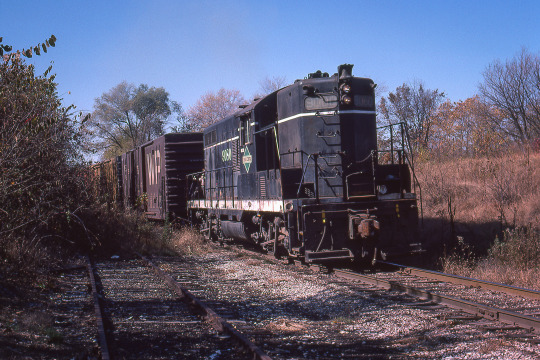


Yard Engine
Here we see the yard engine working a seldom used spur that leads from the main, through a cut, to downtown Bloomington, Indiana. The EMD GP9 was built in February of 1955.
This is along Illinois Central's line between Effingham, Illinois, and Indianapolis. It was the Illinois Central Gulf at the time after a merger with the Gulf, Mobile & Ohio four years earlier.
Three images by Richard Koenig; taken October 28th 1976.
61 notes
·
View notes
Text

Gramps taking kids out for the weekend
135 notes
·
View notes
Text
200 years of railroads apparently
So when I was waiting for the train today I noticed the departure boards saying that it was the 200th anniversary of the railway this year (I believe they’re going off of the Stockton and Darlington Railway, which was the first public railway to use steam engines and opened in 1825). Which is an important milestone in railway history for sure (although whether it counts as when railroads were invented is debatable) and there are definitely many things we can do to celebrate. To start, however, we can look back at these past 200 years of railroad history and some of the major milestones that occurred. Note that this will focus on British & American rail history since that's what I'm most familiar with. With that out of the way, here is a timeline of railway history:
c. 600 BCE: the ancient greeks moved some boats (water vehicles) over land on some rails
1769 CE: James Watt makes a better steam engine, which is why power is measured in watts and not newcomens.
1804 CE: Richard Trevithick makes a steam train but just as a fairground attraction (railways already exist but they use horses for power).
1825 CE: George Stephenson makes a steam train for the Stockton & Darlington Railway, which marks the beginning of the end for horses. In the coming years, millions of horses are sent to farms upstate, around the back of the shed, or off to work at the glue factory.
Steam trains: - faster and stronger than horses - are made of physics instead of biology (much neater & cleaner) - all of their waste goes into the air instead of the ground - you don't have to wait years for them to grow up
1830 CE: The Baltimore and Ohio Railroad (B&O) opens in the United States. While probably not the first railroad outside Britain to use steam trains, it is the first to do so in the United States, and since I don't really know much about, say, Belgian railway history it's the one we're going to be talking about.
1840s CE: Railroads form a crucial part of the US's westward expansion, bringing people and goods west (and east I suppose), along with letting the federal government outsource the genocide of the people who already lived there.
1863 CE: The Metropolitan Railway (eventually the Metropolitan Line) opens in central London, as the first urban rapid transit system. Since electric trains weren't a thing yet, this used steam trains. The smoke from the steam trains killed many people, most notably american President Abraham Lincoln when he visited in 1865.
1879 CE: Werner von Siemens makes an electric train but just as a fairground attraction (railways already exist but they use steam locomotives for power) (also there were prototype electric trains before this one but Siemens is the one with a unit named after him so he's who we care about)
c. 1880 CE: The Pennsylvania Railroad and London & North Western Railway become the largest corporations in the world. It's important to note that although railroads are one of humanity's greatest inventions, they did have the unfortunate side effect of also bringing about the dawn of modern capitalism, one of humanity's worst inventions.
1883 CE: The Volk's Electric Railway opens in Brighton. For a time, it included another line that went in the ocean (with rails on the sea floor and really long legs to keep passengers above the water) but this turned out to be a dumb idea and that part closed. The original Volk's Electric Railway is still open as the oldest operational electric railway, and you can go ride on it in the summer. I'll probably do this to celebrate at some point.
1890 CE: The City & South London Railway (later the Bank branch of the Northern Line) opens, finally providing an electric underground rapid transit system for the city and some much-needed relief from the smoke of steam trains. Unfortunately, this was too late to save Abraham Lincoln, who died from being shot in 1865.
1894 CE: a bunch of american southerners LARPing (but less cool than modern LARPers) as british aristocrats but even more racist (than the british aristocrats. all the LARPers I know personally aren't racist) form the Southern Railway. I mention it now because it'll be important later.
1895 CE: The Baltimore and Ohio Railroad opens the first mainline electric railroad. This doesn't mark the beginning of the end for steam power (although it should have) since most railways are privately owned, electrification costs money, and corporations hate spending money.
Electric trains: - faster and stronger than steam - don't require fuel at all - way quieter and don't create any local pollution (can go in tunnels!) - can be powered by renewables & nuclear, once they are invented (hydro is there from the start though) - can go both directions without needing to turn around - can form multiple units (better acceleration and don't need to move the engine around!) - very low maintenance (not constantly having a fire inside does tend to reduce wear and tear on parts) - generally very good
1912 CE: the first diesel locomotive enters service. This turns out to be what marks the end of steam, since diesels are better than steam but are cheaper (to set up. not to run) than electrics. In the coming years, millions of steam locomotives are sent to branch lines upstate, around the back of the depot, or off to work at the scrapyard.
Diesel trains: - faster than steam. except for normal, unmodified, in-service trains, since the fastest diesel is the Intercity 125 with a top speed of 201 km/hr while the steam powered Mallard reached a top speed of 203 km/hr. - stronger than steam. except they aren't, the most powerful diesel loco is weaker than several steam engines. - slower and weaker than electrics (unlike with steam engines, this isn't even close) - louder and more polluting than electrics (although not as bad as steam) - still require fuel (a different sort to steam locos though, and they don't need much water) - can go both directions without needing to turn around - can form multiple units - don't need overhead wires or third rail, which is the only reason they exist (they're mostly better than steam, and although they're worse than electrics they are cheaper. To set up. Not to run.)
1914 CE: The Milwaukee Road electrifies its Pacific Extension out in the american northwest, since steam trains couldn't go in tunnels and were too weak for the hills.
1917 CE: The United States of America nationalizes its railroads under the United States Railroad Administration, in order to put a stop to the private sector's incredible mismanagement of a vital public service during WWI.
1920 CE: After the war ends, the US hands the railroads back to the private companies. Just like all those other times the US did something really, really, good (i.e. Civil War Reconstruction, free school meals during Covid), the USRA didn't last very long and everything went right back to the terribleness of before.
1923 CE: Britain's railroads are grouped from lots of small (and some big) companies into four big companies: the London and North Eastern Railway (LNER), the Great Way Round Western Railway (GWR), the London, Midland, and Scottish Railway (LMS), and the Southern Railway (the real one, not the american south LARPers or modern-day corporate/french LARPers).
1920s CE: The Southern Railway (UK) electrifies much of its network with 750V DC third rail.
1938 CE: The LNER Class A4 "Mallard" sets the rail speed record, reaching 203 km/hr. This makes it the fastest steam train ever, especially since the Pennsylvania Railroad never discovered dynamometer cars or speedometers and had no idea how fast its trains were.
1948 CE: Britain's railroads are nationalized under British Railways (later British Rail).
1950s CE: Gas-turbine trains are invented. Union Pacific uses them for a while, and they briefly also are used for higher-speed trains in some places, but they never really go anywhere.
Gas-turbine trains: - more powerful than diesels - faster than diesels - very loud and kind of inefficient - these things were a bit strange weren't they?
1955 CE: Steam finally starts to die in Britain under BR's modernization plan, which sees electric (yay) and diesel (boo) trains replacing steam locomotives.
1959 CE: Ernest Marples becomes British Minister of Transport. He's also head of a road construction company. This means he wants more roads and less trains. This is a bad thing.
1960s CE: Dr Beeching (a guy Ernest Marples hired) makes a report suggesting closing most of Britain's rail network, starting with the least profitable and redundant routes. The government then ignores most of the suggestions in the report, and closes down whatever rail lines they feel like. Fortunately, the cuts aren't as large as the report suggested. Unfortunately, they are still enormous and cause huge damage to Britain's rail network that is only just starting to be repaired.
1964 CE: The Tokaido Shinkansen opens in Japan as the world's first dedicated high speed train. This marks the pinnacle of human transportation, and electric high speed rail takes its place as the most efficient, most comfortable, most environmentally friendly, and fastest (below a certain distance) form of transportation. Many other countries start to build their own networks, including France, Italy, Spain, China, Morocco, Turkey, Britain (tries to, anyway), some other places, and a couple failed attempts in the US (along with the successful kind-of-high-speed rail in the Northeast Corridor and the still under construction one in California).
1968 CE: Steam finally dies in Britain. Yes, after the Shinkansen was built. Unfortunately, diesel trains continue to exist to this day.
c. 1970 CE: Running out of money, the Milwaukee Road decides to end electrification, since diesels are much better than they used to be and fuel is pretty cheap.
1971 CE: With passenger service not making enough money (it was making money, just not enough money) due to all of those free government-provided highways and airplane subsidies, the US government under Richard Nixon forms Amtrak to take over passenger services and give them a quiet death. Fortunately, this doesn't work. Amtrak still exists, and Richard Nixon doesn't, so who's the real winner here?
1973 CE: The 70s oil crisis begins, and electric trains are suddenly back in fasion after gasoline and diesel become really really expensive. Except it ends before american railroads do anything.
1974 CE: The Milwaukee Road ends its last electric trains.
1976 CE: The Penn Central, formed from a merger between the Pennsylvania Railroad and New York Central, goes bankrupt and the US government replaces it with Conrail, a sort-of nationalization of some of the US rail network. This doesn't last either, with the network being sold off to Amtrak (who take as good care of it as they can with their limited money), and CSX & Norfolk Southern (who don't, but more on them later)
1977 CE: The Milwaukee Road goes bankrupt.
1980s CE: Several mergers between US railroads result in the B&O (under the Chessie System) becoming part of CSX Transportation (the most boring corporate named railroad in existence), while the Southern Railway (US) merges with the Norfolk & Western to form the Norfolk Southern railway.
1982 CE: The British Rail Class 455 – an electric multiple unit used in south London and the suburbs – is introduced.
1993 CE: Precision Scheduled Railroading – an ingenious way to squeeze as much money out of a railroad as possible while providing awful service, treating employees terribly, never investing in infrastructure until something collapses, not doing basic maintenance, and putting safety fourth – is created, and adopted by all of the largest railroads in North America.
Also 1993 CE: The privatization of British Rail begins. Generally considered a bad idea that even Thatcher wasn't going to do (although her privatizing everything else certainly encouraged it), it ends up creating a mess of privately owned companies, half of which end up being owned by foreign state-owned railway companies like SNCF and Trenitalia.
1994 CE: the british and french moved some trains (land vehicles) under water on some rails
c. 2000 CE: people start to care a lot about climate change, and then notice that electric trains are the most environmentally friendly form of transport (apart from walking I guess but let's see you walk anywhere from tens to hundreds of kilometers every time you want to go to a city you don't live in). Car traffic and local air pollution caused by cars are also problems, which trains can solve. (even diesel trains aren't as bad as cars. whether steam trains are as bad as cars is left as an excercise for the reader)
2001 CE: for no particular reason, planes become unpopular, americans suddenly remember trains exist, and Amtrak's brand new (introduced 2000 CE) sometimes high speed train the Acela becomes very popular.
2002 CE: after it turns out privatizing infrastructure and maintenance was a really bad idea that killed people, Britain's railway infrastructure is renationalized under Network Rail (that's us!)
2008 CE: massive financial crisis happens. China decides to spend hundreds of billions of dollars on high speed rail, the US (and to a lesser extent Europe) decide to spend hundreds of billions on bailing out the banks instead
c. 2018 CE: Battery-electric trains (which had existed in some form or another for over 100 years) and hydrogen powered trains (which were new) become things, because of the previously mentioned hatred of spending money by railroads (the pressure to at least appear sustainable combined with the desire to not spend any money on electrification caused these to exist)
Battery-electric trains - weaker and slower than all other types of train - terrible range (need charging very frequently) - require loads of rare earth metals - can catch fire really badly - the batteries eventually wear out (and are not as easy to replace - as the parts of other trains) - completely useless if you need high frequencies or long distances (you'd need to charge them so often that you'll end up reinventing third rail/overhead line electrification) - JUST ELECTRIFY PROPERLY DAMN IT
Hydrogen trains - anything hydrogen powered is either a scam or is going to explode. or both. explosions are only a good thing when going to space on a rocket and only when controlled. - why do these exist - why
2019 CE: In a major milestone for the company, Amtrak almost breaks even for the first time in its existence. (STOP TRYING TO MAKE IT TURN A PROFIT IT'S A PUBLIC SERVICE AND NEEDS AT LEAST AS MUCH MONEY AS THOSE SOCIALIST NATIONALIZED HIGHWAYS GET ALONG WITH SOME EXTRA FOR ALL OF THE MONEY THEY'VE MISSED OUT ON)
2020 CE: a global pandemic happens and everyone stays home. this means all of the privately operated train companies in the UK start losing loads of money (although a bunch of them were already government-owned. some even by the british government) and the conservatives are forced to do something. they do it badly as usual.
2020s CE: the british conservatives cancel almost all of HS2 except the bit that goes from Birmingham to near London (because they hate the north of england, and transit users, and the environment, and young people, and londoners, and effective infrastructure, and recovering from the pandemic, and investing in the futrue, and everything good in the world; and also because of the cost overruns and delays that they caused). They plan to start selling off the land safeguarded for the route so the north of England will never have high speed rail (or anywhere else in the country that didn't already have HS1. so basically everywhere except London) and no future government will be able to revive the project. Fortunately they lose the election before they can do this. Unfortunately the new government refuses to revive it (except saying it'll at least go to London), so the various northern mayors have to try and scrape together the money to build whatever replacement they can afford with the money they've found in the couch cushions.
2021 CE: Amtrak gets a whole bunch of money. Not as much as the highways get, but a lot more than they usually get, and they start making big plans, and there is some high speed rail still in progress in California (it's taking a while but they're still building all of it), and there may even be some in other places soon too.
2023 CE: Norfolk Southern blows up East Palestine (the town in Ohio) after dumping loads of toxic chemicals there, thanks to Precision Scheduled Railroading techniques. They mostly get away with this. Safety fourth!
2024 CE: The british government finally announces it's going to renationalize the railways under Great British Railways (and unlike the conservatives they actually use the term "renationalize"). Also, Network Rail is now on the tumbles (you're reading a post from it right now).
2025 CE: The first british train operating companies are set to be nationalized under GBR, just in time for 200 years since the Stockton & Darlington opened.
#network rail#network rail essays#Railway 200#railway history#this took a while#I may still be jetlagged#I did do some actual research to make sure I had the dates right#it is funny to imagine Abe Lincoln taking the metropolitan line#he totally could've done it#maybe it was after he got back from faxing a samurai#anyways thats enough writing for tonight#enjoy this somewhat informative and hopefully funny timeline of railway history
5 notes
·
View notes
Text
Class 323 tribute






Today marks the end of an era for railways here in the West Midlands as the class 323 units bow out of service in the region, moving onwards to join their siblings in the Manchester area. For 30 years, the 323s have been the backbone of electric commuter services around the West Midlands. Designed in connection with the then recently electrified Cross-City Line in 1993, the class didn't have the most auspicious start in life, their introduction into service being delayed by technical faults and then they suffered further teething troubles after they finally entered service in 1994, but ultimately, their issues were resolved and the units settled down to give many years good service to BR Regional Railways' Central division and it's privatised successors Central Trains, London Midland and West Midlands Railway. Now, after 30 years, the class has been replaced by the new class 730 units, and so another era hits the buffer stops of railway history. Farewell West Midlands class 323 units; 1994-2024. Thank you for all the good service you've given us and good luck with those Manchester boys!
#trains#electric multiple unit#br class 323#class 323 farewell#railway history#I'm gonna miss these trains and their sci-fi sounds!
2 notes
·
View notes
Text

Detail of German steam locomotive 98 307, originally built for the Royal Bavarian State Railways in 1908. Due to its unconventional cab design the loco‘s nickname became "glass box". It‘s been in service for more than 50 years until 1962.
* * * * * * * * * *
Detailaufnahme der 98 307, ursprünglich 1908 für die Königlich Bayrischen Staatsbahnen gebaut. Die Lokomotive trug wegen der Form ihres Führerstands den Spitznamen „Glaskasten“ und wurde mehr als 50 Jahre lang bis 1962 eingesetzt.
📸 Mine, at Deutsches Dampflokomotivmuseum in Neuenmarkt-Wirsberg.
#steam locomotive#trains#railway#railway history#dampflok#eisenbahn#steampunk#history of technology#vintage#retro#kbstsb#steam train#museum
35 notes
·
View notes
Text
Unwittingly celebrated World Heritage Day last Saturday with a trip to the Swansea Model Rail Exhibition, from which I've been sorting & editing footage and uploading with the ultimate view of creating a YouTube compilation, so time now to feature the first model railway to have all footage taken now uploaded.
Box Station is an N scale model railway built by the Swansea Railway Modellers' Group, the original subject matter being a station on the Great Western Mainline between Bath and Chippenham. The nameplate of the signal box is now preserved at the National Rail Museum. Some of these videos I have slowed down from the original running speed as seen on the model last weekend so as to give a more realistic appearance.
It was also here that the Rev. W Awdry, author of the Thomas the Tank Engine books came to watch the trains passing through, as he lived nearby, and he himself relates how the stories were inspired by hearing the freight trains passing by night, banked by tank engines who would push from behind on trains too heavy to be hauled up the gradient by the main locomotive detailed for the run, and imagining the different puffing patterns of the different sized locomotives as being them talking to each other.
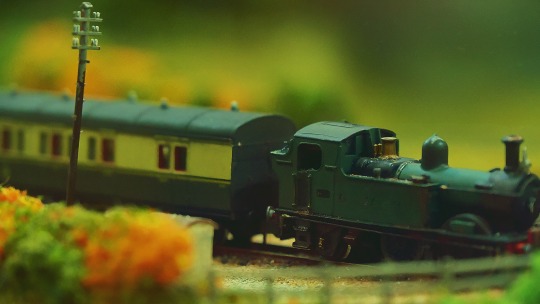
#Great Western Railway#Box#steam train#railways#Great Britain#England#railway station#steam locomotive#model railway#N scale#Rev W Awdry#Thomas the Tank Engine#World Heritage Day#model train#Great Western Main Line#railway history#express train#historical photography#digital content creator#heritage#classic train#culture#passenger train#railway culture#literature#popular culture#1:148 scale#literature inspiration
11 notes
·
View notes
Text
A micro-adventure photo shoot in the Yorkshire Dales
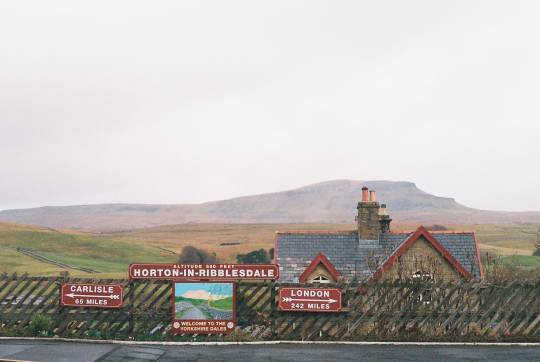
The station at Horton-in-Ribblesdale. It was a very monochrome kind of day but the colours are still quite vibrant. Love shooting on film! Pentax MV / Kodak Gold 400
The biking back story
I used to absolutely love mountain biking. My sister introduced me to the sport as a way of keeping fit, just after I realised that something evil was afoot regarding my health. Loved it. Turns out I am a total speed freak mud junkie, and it was with a very heavy heart the mtb went into the shed, reluctantly discarded for a hybrid ebike.
It’s a lovely machine, but to me it represents what I can’t do rather than what I can - especially as the distances are slowly but surely reducing down to around 8km-10km a week and counting. Backwards.
Anyway. To break the monotony of the ‘from the doorstep’ routes I had the idea of taking my e-bike on the train. A blindingly obvious idea, seeing as I live on the infamously scenic Settle to Carlisle Railway.
For those not in the know, this line is among the best known rail journeys in the UK, and easily one of the most scenic. It stretches 73 miles (117km) from Settle in Yorkshire, crosses the dramatically beautiful Pennines - the ‘roof of England’ - and ends at Carlisle in Cumbria.
More info here, for those that need it: The Settle & Carlisle Railway Trust
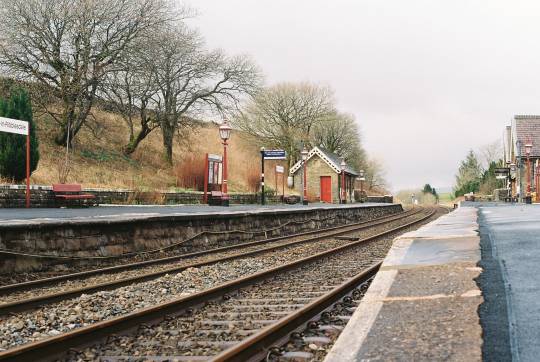
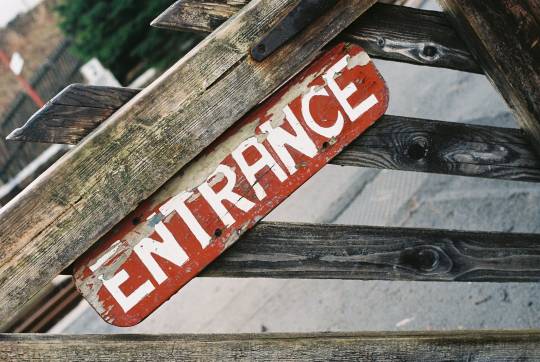
Pentax MV / Kodak Gold 400
Disappointing the Strava Gods
The 12.34 train from Kirkby Stephen arrived at Horton-in-Ribblesdale about half an hour later. It was cold, REALLY cold. Drizzly. Almost wished I hadn’t bothered to be honest. A quick squint at Google Maps took me a mile down the road to the (lovely) Middle Studfold Farm tea rooms, where I refuelled my enthusiasm with food.
The Dales village of Horton-in-Ribblesdale, even on a grey day, is undeniably stunning. Not much was open, which is to be expected in February, but there wasn’t much to be open even in summer. It’s a perfect destination for cyclists, walkers and peace-seekers who find the nearby Lake District just a bit too hot to handle when the holiday crowds descend.
I kept the route short, around 7km in total, and stuck to exploring some of the tiny back lanes in search of some nice photography moments. Hardest part was trying to turn a blind eye to the absolutely perfect mtb terrain…
I used to get pointlessly upset about my decreasing Strava kudos. Mercifully I’ve managed to cut myself some slack on this, I now no longer feel I have to appease the Gods of Strava and worry about those little pixellated trophies. Chasing QoM is yet another Thing I’ve allocated to the mental storage unit of ‘You Did It, Though’.


Pentax MV / Ilford HP5 and Kodak Gold 400
All the photos in this blog were taken - through necessity - from the roadside, but perhaps it goes to show you don’t always have to hike off the beaten path.
The Ribblehead Viaduct
For the benefit of Ribblehead Viaduct newbies, it is the most impressive structure on the Settle-Carlisle Railway, and was constructed between 1869 and 1874.

Pentax MV / Kodak Gold 400
The day after this mini adventure I was disappointingly very sore indeed, tragic Strava stats to one side I’m very glad I didn’t try anything fancier. I’ve promised myself I’ll bring the bike back to the Settle-to-Carlisle line in warmer weather, maybe hop off at Ribblehead Viaduct. Even if at that point I’m down to 5km, 3km, 1km or hobbling off the train with a picnic, it’s still better than not going at all.
Til next time folks, peace out.
#Film Is Not Dead#Photography#35mm#35mm Film#Film Photography#No Filter#PentaxMV#Embrace The Grain#B&W#B&W Photography#Colour Photography#Photo Blog#Yorkshire Dales#railway history
3 notes
·
View notes
Text

First U.K. railway company to electrify - way ahead of the curve
1 note
·
View note
Text
The beauty and permanence of the mundane...

So, I noticed this detail in the pediment of a pilliar at the station I've been traveling to and from regularly for the past 3 months or so.....
On it's own, this doesn't seem like much, but these 3 letters of CLC are a mark of the Cheshire Lines Committee. A minor railway company formed in 1860 through a joint venture by 2 other railway companies (and which completely dissappeared in 1947) but was still proud enough to mark it's bildings in a way which is noticeable even today, over 150 years later (and nearly 80 years after the company itself ceased to exist). I just think there's something emotional about that.
Linky for those interested:
https://en.m.wikipedia.org/wiki/Cheshire_Lines_Committee
0 notes
Text

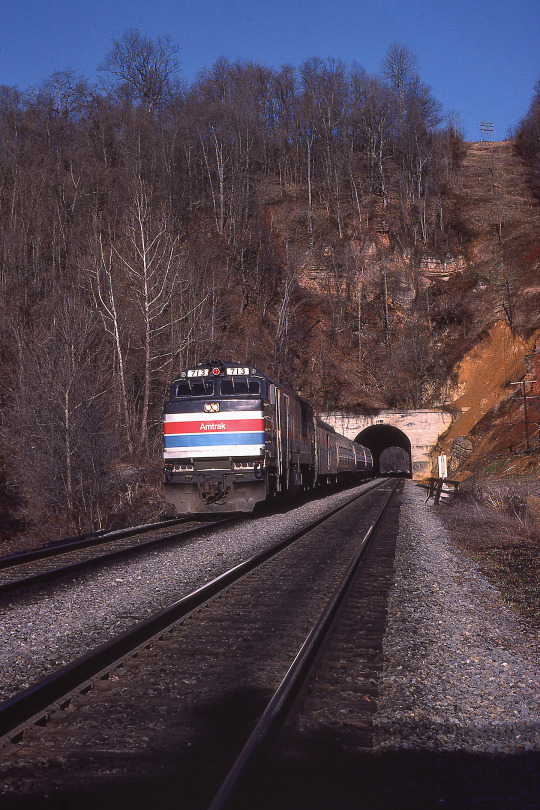
Mud Tunnel
Here are two shots taken at Mud Tunnel on the Chesapeake & Ohio. This spot is just west of Covington, Virginia. We first see a westbound freight and then the eastbound Amtrak James Whitcomb Riley powered by a General Electric P30CH.
Update: someone on FB tells me this locomotive was destroyed later in 1977 when it struck a logging truck near Florence, SC.
Two images by Richard Koenig; taken March 23rd 1977.
#railroad history#railway history#amtrak#jameswhitcombriley#covingtonvirginia#covingtonva#covington#c&o#chesapeake & ohio
54 notes
·
View notes
Text

“The Council will decide your fate.”
R Class 761, R Class 707 - City of Melbourne & A3 Flying Scotsman
#flying scotsman#on the rails#real railway#railway history#steam engines#steam engine#australian steam#australian engine
49 notes
·
View notes
Text
The Haunting of the Pacific Electric Building in Los Angeles
The Pacific Electric Building in Los Angeles, a towering landmark steeped in history, stands as a silent witness to the city’s vibrant past. However, beyond its architectural grandeur and historical significance lies a darker side, a realm of eerie tales and unexplained phenomena that have earned it a reputation as one of the most haunted buildings in Los Angeles. Indeed, the Pacific Electric…
#Cold Spots#Downtown Los Angeles#Elevator Anomalies#Ghost sightings#Ghost Stories#Ghostly Conductor#haunted locations#los angeles#Pacific Electric Building#Paranormal Activity#Phantom Passengers#Railway History#Red Car System#Unexplained phenomena
0 notes
Text
Day 27: The George Robert Stephenson Fountain: A Tribute to Engineering Excellence on The Green, Cowes
Introduction The George Robert Stephenson Fountain, located on The Green in Cowes, Isle of Wight, stands as a lasting tribute to one of Britain’s most significant engineering families. Erected in honor of George Robert Stephenson, a pioneer of railway engineering, the fountain is a blend of Victorian design, engineering history, and local pride. Positioned near the Cowes waterfront, it serves as…
#A Tribute to Engineering Excellence on The Green#Architexture#article#British Engineering#Colour#Cowes#Cowes Attractions#Cowes Green#Cowes history#Cowes Waterfront#Engineering Heritage#Engineering Pioneers#George Robert#George Robert Stephenson Fountain#Historical Monuments#HistoryOfBlinds#Isle of Wight#Isle of Wight Culture#Isle of Wight landmarks#Isle of Wight Tourism#maritime heritage#Maritime Monuments#Photography#Public Monuments#Railway History#Sea#Seaside#Stephenson Family#The George Robert Stephenson Fountain#The Green Cowes
1 note
·
View note
Text

German heritage loco 01 519 on her way from Würzburg to Neuenmarkt-Wirsberg.
* * * * * * * * * * *
Museumslok 01 519 auf dem Weg von Würzburg nach Neuenmarkt-Wirsberg.
📸 Mine
#railway#steam locomotive#mine#eisenbahn#history of technology#steampunk#history#retro#railway history#museum#gif#dampflok
6 notes
·
View notes
Text

British Rail Western Region/Great Western steam locomotives Nos 5043 Earle of Mount Edgecombe and 7029 Clun Castle double head the returning Mayflower steam service through the dusk shadows, passing Norton Fitzwarren shortly after sunset. This was about as much rail-related photography as I got attempting to beat the train to Dainton, only to have a delayed CrossCountry train, a missed bus, and a trip on the wrong bus thwart my attempt earlier in the day. Going for the evening shot, my camera conveniently decided to refuse to focus in manual mode just as the train was already in view, so a had to make a rapid switch to auto mode and hope for the best. Considering the way the shot looked in camera, I can't say I'm that upset with the final result post processing.
#heritage#history#photography#train#British Railways#steam locomotive#Somerset#Taunton#Norton Fitzwarren#dusk#historical photography#express train#Clun Castle#steam train#Western Region#Pullman#Mayflower#landscape#Great Western Railway#steam engine#double header#passenger train#British Rail Mk1#Vintage Trains#railtour#railway history#England#Great Britain#Europe#railway heritage
1 note
·
View note
Text
youtube
Want to know about the privatisation of British Rail in the 1990s? This illustrative video explores the pros and cons of this significant change. Find out what happened when British Rail, the national rail system, was privatised. If you're interested in understanding the effects of privatisation on British rail, this video is for you! Watch it here.https://www.youtube.com/watch?v=kstBqyFej-4
0 notes